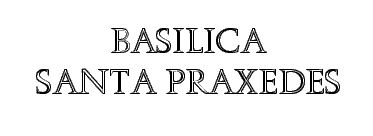
| To understand the early history, cast of characters, and
iconography of this basilica, one needs to be familiar with the story of
the Pudens family. That story tops the page on Basilica Santa
Pudenziana.
After the martyrdom of Senator Pudens and his wife Priscilla, the daughters, Pudentiana and Praxedes, continued to be fervent Christians and devoted their life to the Church. After the death of Pudentiana, Praxedes inherited the family wealth from her brother Novatus and built a house at this location. Praxedes devoted the house to the Christian community and not only provided for it's use as a domus ecclesiae (house church) but concealed a large number of Christians being sought by the government during the persecutions of emperor Antoninus Pius. An oratory was built on the spot around 150 A.D. and later a titular church. The present basilica dates from the early 9th century A.D. when it was built at the direction of Pope Paschal I. Like all Roman basilicas, it's been continually renovated in parts over the centuries. This basilica is located only a few hundred feet from the papal basilica Santa Maria Maggiore. The entrance to Santa Praxedes is tucked into a small alleyway and a detailed map is quite handy in finding it. The original courtyard entrance is locked up and hasn't been in use for quite some time. Access is now through that alley doorway into the right transept. |
|
|
|
The nave of the basilica suggests a strong reaction against the iconoclastic movement of the Byzantine church which apparently didn't do well in enforcing their thoughts against imagery on the Roman church. It's hard to find much wall space in Santa Praxedes that is not covered by an image. The nave has 16 granite columns and 6 piers. |
|
|
|
Santa Praxedes is noted for it's mosaics. Not only does it have probably more mosaics than any other church in Rome in comparison to it's size but the state of preservation is the best. From left to right are Pope Paschal I (square halo indicating he was still alive when the picture was made and the model building he holds indicating he is the builder), St. Praxedes, St. Paul, Jesus, St. Peter, St. Pudentiana, and St. Zeno. Above Christ's head can be seen the Hand of God reaching down from Heaven. |
|
|
|
The triumphal arch bordering the apse is covered with symbolism Here a group of 12 men (the Apostles?) offer up a crown. Whole books have been written to catalog the imagery of mosaics in the basilica. |
|
|
|
The Lacunar ceiling was installed in 1868 built with wood from the forest of the Florentine abbey of Vallombrosa. |
|
|
|
The most well-known part of the basilica is the Chapel of St. Zeno, built by Pope Paschal to house the remains of his mother. The interior walls and ceiling of the small chapel are totally covered with mosaics, as is the area above the doorway outside shown here. |
|
|
|
The ceiling of the Chapel of St. Zeno. |
|
|
|
The mosaic altarpiece of the Chapel of St. Zeno shows the Madonna and Child flanked by St. Pudentiana and St. Praxedes. |
|
|
|
This upper wall section has mosaics depicting St. Peter and St. Paul flanking the throne of Christ. |
|
|
|
This upper wall section shows (l. to r.) St. Agnes, St. Pudentiana, and St. Praxedes. |
|
|
|
This upper wall section shows (l. to r.) the Apostles John, Andrew, and James. |
|
|
|
In a tiny reliquary chapel adjoining the Chapel of St. Zeno is displayed this reputed portion of the column in the courtyard of Pontius Pilate in Jerusalem to which Jesus was chained while being scourged. |
|
|
|
The confessio under the main altar of the basilica house the Crypt which contains four sarcophagi. One is claimed to contain the remains of St. Pudentiana and St. Praxedes, and the other three contain remains of various other martyrs retrieved from the Catacombs of Priscilla. |
|
|
|
The painting above the altar in the crypt isn't as old as it looks. It's in very poor condition and is thought to date from the early 18th century. |
|
|
|
Near the left rear of the nave is this statue of St. Praxedes. The stone slab behind the statue is supposed to be the one on which she slept. |
|
|
|
The Chapel to St. Charles Borromeo located on the left aisle was built in the early 18th century. The altarpiece painting The Roman is by Stefano Parrocel; it shows Borromeo thanking God for the end of the plague in Milan. This is symbolized by the angel above sheathing his fiery sword. |
|
|
|
The front chapel on the left aisle is the Chapel to St. John Gualbert, founder of the Vallombrosan monks. This is a thoroughly modern chapel now, having been redone in 1933. |
|
|
|
The stained glass windows above the altar of the Cesi Chapel on the right aisle, depicting St. Praxedes and St. Pudentiana. |
|
|
|
Near the right entrance to the basilica is this small fresco Madonna della Salute by an unknown painter of the 13th century A.D. |
|
|
|
On the other side of the chapel is a large wooden crucifix by an unknown 14th century artist. It is reported that St. Bridgid of Sweden (1303-1373) came to pray before this crucifix often and that the crucifix talked to her. |
|
|
|
The Neocosmatic floor was created in 1916 to replace the badly deteriorated original. The circle surrounded by writing marks the spot of St. Praxedes' well where she placed the remains of martyrs which she retrieved. |